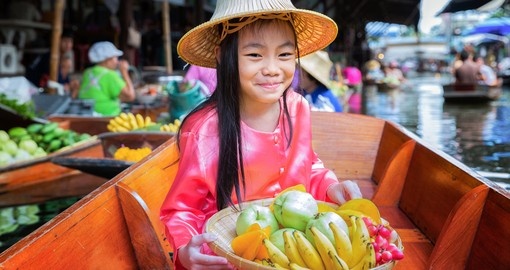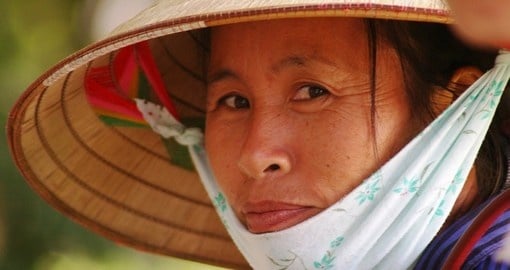Thailand And Vietnam
Below is a sample itinerary of a past Goway Group. It is provided to give you an idea of what we have already done & what you might also consider doing.
However, because of timing, your own group's special interests and budget, we expect to custom make a program just for you. Contact your favorite travel agent click on "Inquire about this Trip" to fill out a request for a group quotation.
Depart Home
Arrive in Bangkok
Arrive at Suvannabhumi International Airport (Bangkok airport)
After clearing immigration and customs, meet our guide at the arrival hall area and transfer from the airport to check-in at your hotel. Time at leisure.
Overnight in Bangkok
Bangkok Sightseeing
Start your day with a boat ride on Klongs (canals) of Thonburi situated on the west side of the river from Bangkok. This is an excellent chance to observe and photograph the serene family homes and temples along the waterways, all of which helped gave the city the nickname of “Venice of the East.” A highlight of this trip includes Wat Arun (the Temple of Dawn), a major riverside landmark. This magnificent shrine is decorated with ceramic pieces from top to bottom and has a pagoda, which soars 79m into the sky.
Leave Klongs, visit The Grand Palace and Wat Phra Kaew (the Temple of the Emerald Buddha) – Together, these two sites form what many consider the greatest spectacle for visitors to Bangkok. Dating back to 1782 (when Bangkok was founded), the entire compound consists of over 100 brightly colored buildings, golden spires and glittering mosaics. Because of its popularity, this destination is often extremely crowded, but still an essential part of any trip to Bangkok.
Presently, the Grand Palace is used for the occasional ceremony and is no longer the royal residence (the present King Bhumibol lives in Chitralada Palace, located in Bangkok's nearby Dusit district). The interiors of most of the buildings in the Grand Palace are closed to the public
Wat Phra Kaew adjoins the Grand Palace in a common compound and is the home of the country's most famous Buddha statue (also known as the Emerald Buddha). This important figure has a long and interesting history that is tied to the royal family and once resided in nearby Wat Arun. It is relatively small (about 66cm) and is situated in a high position in the Wat to signify its important status in the Thai kingdom
Wat Po (the Temple of the Reclining Buddha) - Bangkok’s largest temple is most famous as the home of a giant reclining Buddha statue (45 meters long), but there is also much more to see here. Four large Chedis (and 73 small ones) 394 Buddha statues, and a Bodhi-tree are situated throughout the compound and about 300 monks reside in the monastery.
Wat Benchamabopit (the ‘Marble Temple’). This magnificent monastery was built with white Italian marble from Carrara and is an exotic and romantic temple to visit. Then pass through local market, Flower Market & China Town before returning to your hotel.
Overnight in Bangkok. B
Samut Songkhram – Mangrove Planting Project
This morning, you will travel south to Samut Songkhram province (An approximately 1.5-2.0 hrs drive), where you will participate in ‘Mangrove Planting Project’.
Klong Khone is a small community located in Samut Songkhram that suffered in the past from deforestation and forest degradation. Led by the village leaders, an initiative to restore the mangrove forests and follow a more sustainable socio-economical path has turned Klong Khone around today into an award-winning eco-tourism location.
Today the community forest of Klong Khone is rich in biodiversity and the locals have better livelihoods from sustainable fisheries and eco-tourism. The community also established the Klong Khone Mangrove Conservation Center which overlooks mangrove conservation, helps manage sustainable eco-tourism for the community, and raises awareness about mangrove forests to the general public.
The program includes:
- Cruise to the mangrove forests where Princess Maha Chakri Sirindhorn together with locals started the Mangrove Planting project. The visitors will also have a chance to plant your own mangrove.
- 1 lunch at local hut.
- Visit oyster and mussel farms and skiing on cockle farm
Return to Bangkok and transfer to your hotel.
Overnight in Bangkok. B
Bangkok – Hanoi - Thanh Xuan Peace Village (Orphanage)
This morning you will be transferred to Suvannabhumi International airport (Bangkok airport) to board a flight to Hanoi.
On arrival at Noi Bai International airport (Hanoi Airport) After clearing immigration and customs, meet our guide at the arrival hall area and transfer from the airport to check-in at your hotel.
This afternoon, travel 10 km. south of Hanoi to visit an orphanage house, Thanh Xuan Peace Village
Thanh Xuan Peace Village aims at humanitarian, good-natured and medically oriented targets for the sake of children with bad luck, suffering from congenital and other causes especially damaged by herbicide used during the wartime. By doing so, the essential purposes of Thanh Xuan Peace Village are to get back these ill-fated children into the community, integrating their life into the living rythm of the whole population. Our establishment takes the responsibility of breeding, caring, rehabilitating, (mentally and physically) cultural teaching, computer teach and stone-fine art for children admitted
The volunteer could participate in:
- Helping staff with general housework
- Teaching English to children and staff
- Singing songs and playing games with the children
- Joining daily activities with the pupils including assisting with exercise
This evening, visit a water puppet show. A fantastic art form originating in northern Vietnam, best seen in Hanoi. Transfer back to your hotel.
Overnight in Hanoi. B
Halong
Excursion by boat through Halong Bay including lunch (4 hours). Board your charming traditional wooden junk for cruising through the Bay. En-route lunch will be served. Following cruise by rock formations with such names as Stone Dog, Incense Burner (Dinh Huong), Fighting Cock (Ga Choi). At the core of the islets, there are two wonderful caves and grottoes to visit as Thien Cung (Heavenly Residence Grotto), Dau Go (Driftwood Grotto). Disembark at Halong pier. By vehicle from Halong back to Hanoi.
Overnight in Hanoi. BL
Hanoi – Hue
Although it is the modern-day capital of Vietnam, Hanoi still retains the mystery and charm of past centuries. Narrow lanes and traditional shophouses invite an exciting exploration by walking, while its many beautiful public spaces - lakes, parks, tree-lined boulevards and monuments - give the city an air of elegance and harmony with nature unique among Asian capitals.
Begin your day visiting the Temple of Literature, a peaceful series of walled courtyards and graceful gateways, and one of the best-serving examples of traditional Vietnamese architecture. Founded in 1070 and dedicated to Confucius, this was also the site of Vietnam's first university.
Continue to the miniature One Pillar Pagoda. Also dating from the 11th century, this monument was rebuilt after being destroyed by the French in 1954. After the pagoda visit, walk through the park to Ho Chi Minh’s Stilt House, the simple two-room dwelling where Ho Chi Minh lived from 1958 until his final days (1969). Preserved in the same condition as, during his life, it may be viewed through the windows.
Finally, discover the Old Quater of Hanoi by walking. This fascinating network of narrow alleys and shophouses is also known as 'The 36 Streets,' each street being named after the merchandise traditionally sold there, ranging from fabrics to crafts to medicines to tombstones. A handicraft lover's paradise and an endlessly interesting place to explore local life. Transfer to Hanoi airport. Flight to Hue and transfer to your hotel for check-in.
Overnight in Hue. BL
Hue – Sightseeing
After breakfast today your sightseeing will begin in the heart of Hue at the Imperial Citadel, a vast complex built in the early 19th century and modelled after the Forbidden City of Peking. The original walls stretched for 10 km and were surrounded by a wide moat.
Today, most of the buildings have been destroyed due to bombing during the Vietnam-American War, but the monuments that remain provide a fascinating glimpse into the court life of the Nguyen Dynasty. Approach the city past the striking Flag Tower, where a giant Vietnamese flag waves proudly overhead, to the imposing Ngo Mon Gate, the main entrance to the Imperial Enclosure. Enter into an area of spacious courtyards and serene lotus ponds, and visit Dien Tho Residence (Dien Tho palace) is where the Queen's mother lived, visit Thai Hoe Palace, the magnificently decorated reception hall, the Halls of the Mandarins, and the original Nine Dynasties Urns, among other sites.
Visit the Imperial Tomb of Emperor Tu Duc, who ruled Hue more than 100 years ago, built his tomb when he was still alive and used it for meditation, reading and theatre performances. There are pavilions in a tranquil setting of forested hills and lakes. The tomb was constructed between 1864 and 1867. Tu Duc, who was the longest-reigning Emperor, lived a luxurious life. Visit local Dong Ba Market.
Overnight in Hue. B
Hue – Danang – Hoi An
Excursion to Thien Mu Pagoda with a boat trip on the Huong Giang river Embark on a local boat and cruise down the Perfume River to the iconic Thien Mu Pagoda, an elegant seven-tiered octagonal tower that has become Hue's most widely recognizable monument. During the early 1960s, this became a center of anti-government protest and the site of the famous self-immolation of the monk Thich Quang Duc. By vehicle from Hue to Hoi An with sightseeing in Danang.
The journey from Hue over scenic mountainous roads with spectacular views over the coastline. Halfway between Danang and Hue lies the dramatic Hai Van Pass, the high dividing line between the climate zones of north and south Vietnam. Continue southwards passing Lang Co Beach, a lovely stretch of beach curving outwards between a clear blue lagoon and the South China Sea.
After arriving in Danang, tour the CHAM MUSEUM, an elegant colonial building that now houses the finest collection of Cham sculptures in the world and briefly passes Non-Nuoc Beach, a famous spot for American soldiers during the Vietnam-American War. Continue south to Hoi An, stopping en route to visit the Marble Mountains, five stone hillocks, once islands, that now rise sharply from the surrounding ricefields. Riddled with caves and shrines, they are said to each represent one of the five elements of the universe.
Overnight in Hoi An. B
Hoi An - Sightseeing
Hoi An is a picturesque riverside town south of Danang. Known as Faifo to early western traders, it was one of South East Asia's major international ports during the 17th, 18th and 19th centuries. Now, this beautifully preserved historic city is best seen on foot. The walking tour includes: Japanese Covered Bride Pagoda: the first bridge on this site was constructed in 1593 by the Japanese community of Hoi An to link the town with the Chinese quarters across the stream. The bridge was provided with a roof so it could be used as a shelter from rain and sun.
Sa Huynh Museum: located near the Japanese Covered Bridge, it contains exhibitions from the earliest period of Hoi An's history. Tran Family Chapel: this house for worshipping ancestors was built about 200 years ago with donations from family members. The Tran family traces its origins to China and moved to Vietnam around 1700. The architecture of the building reflects the influence of Chinese and Japanese styles.
Phouc Kien Assembly Hall: Chinese pagoda built around 1690 and then restored and enlarged in 1900. It is typical of the Chinese clans that were established in the Hoi An area. The temple is dedicated to Thien Hau Thanh Mau (Goddess of the Sea and Protector of Sailors and Fishermen).
Lantern Making Workshop: Visit one of the lantern workshops in Hoi An. The framework of lantern will be made by the industry itself and clients can observe locals making silk cloth on the lantern. Time at leisure.
Overnight in Hoi An. B
Hoi An – Danang – Saigon
By vehicle from Hoi An to Danang and then a Flight from Danang to Saigon
Sightseeing in Saigon
A vibrant metropolis, Saigon teems with energy, activity and motion. Everywhere you look, you see the meeting of traditional and modern life. The emerging modern skyline stands cheek by jowl with colonial buildings and traditional temples. Outside on the streets, young professionals zip by on motorbikes, chatting on cellphones; inside the quiet temple courtyards, worshippers pray amidst clouds of incense.
Begin your tour into modern history with a tour of the Reunification Palace. Formerly the Independence Palace of the South Vietnamese president, this 60s style building was famously stormed by tanks on April 30, 1975 signifying the fall of South Vietnam. It has been preserved in its original state, and the original tanks remain on display near the entrance gates.
Afterwards driving to the historic center to visit Emperor of Jade Pagoda, one of Saigon's most interesting pagodas. Proceed to pay a quick visit to the neo-Romanesque Notre Dame Cathedral and the Central Post Office. Pass by the classic European-style landmarks such as the ornate City Hall (hotel de Ville), the old Opera House (both may only be viewed from the outside). Finally, end up at the central Ben Thanh Market, where vendors display a vast array of goods and handicrafts, appealing to every taste. Transfer back to your hotel.
Overnight in Saigon. B
Saigon - Thien Phuoc Orphanage Village
Excursion to Cu Chi Tunnels. Never discovered by American forces, the Cu Chi Tunnels were an important Vietcong base during the American War. Stretching over 200 km, this incredible underground network, dug by hand out of hard laterite, connected command posts, hospitals, shelter and weapon factories. Today, you can walk through the area and learn about the day-to-day life of the VC, see the cleverly disguised entrances and elaborate booby-traps, and even venture inside the tunnels, some of which have been modified to accommodate tourists.
On the way back to Saigon, make a visit to Thien Phuoc Orphanage Village.
Thien Phuoc was established in 2001, and now caters for more than 120 children. It is non-governmental organisation acting under the Catholic Committee of Ho Chi Minh City. It is a residential centre providing healthcare, rehabilitation and education.
The village provides daily physiotherapy sessions to improve the children’s muscular function and flexibility.
Here activities that can be included:
- Teach children how to care for themselves and others.
- Playing, singing and dancing with children
- Learn about living with a disability.
- Teaching them English and helping the therapists.
- Help to fix furniture, clean up the room and surroundings.
- Bringing them presents such as notebook, pen and little toys (for skills improvement)
Transfer back to your hotel.
Overnight in Saigon. B
Saigon
You will be transferred to Tan Son Nhat airport (Saigon airport) to board your homebound flight.
Get a Trip Quote Order a Brochure


















